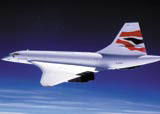Ground control
As Concorde begins counting down to its final flight, Hannah Booth takes a look at its contribution to design and the work that never made it on board

It’s small, hot, noisy and expensive. It was designed in the 1950s, built in the 1960s, launched in the 1970s, flourished in the 1980s, faltered in the 1990s and, this Friday, it retires.
Concorde’s final scheduled flight, the BA002 from New York’s JFK to London Heathrow, marks the misty eyed, lump-in-the-throat, end of an aviation era. Its recent, with hindsight precipitous, refurbishment has taken standards in aircraft design to new heights. But much of the work was never implemented, and never saw the light of day. That is, until now.
In the mid-1990s, British Airways, which owns seven Concorde aircraft, decided to strip down its ageing fleet and give it one last major service. Back then, Concorde was planning to fly until at least 2010. It made sense to refurbish the interiors at the same time, says former BA brand guardian Paul Wylde, who wrote the Concorde refurbishment brief and oversaw the project, and £14m was set aside.
‘The business case for the redesign was to make the planes lighter,’ Wylde explains. ‘The fuel saving would, in theory, pay for the project. The design case was to redefine the Concorde experience, and “bring the outside in”.’
Conran & Partners was approached in 1998, initially to redesign the Concorde ‘room’ – ‘lounge’ sounds ‘suburban’, says C&P managing director Richard Doone – at New York’s JFK airport, which reopened in December 1999. ‘Passengers had always loved the in-flight experience, but the terminals never matched that,’ Doone says. The redesign of Heathrow’s Terminal 4 ‘room’ followed a year later.
C&P was then appointed to refurbish Concorde’s softer cabin interior elements, from carpets and finishes to cashmere-style throws, leather bread baskets and cutlery (downgraded from stainless steel to plastic after 11 September 2001, says C&P associate product designer Mark Hales, who led this aspect of the project).
BA appointed the then newly formed product group Factory Design to look at harder elements, including the seat, the galleys and the washrooms. The former, in ‘BA blue’, features a patented alloy arm and Concorde logo detail. It was Factory, too, that added a touch of excitement – a proposed ‘Machometer’ and a blue ‘wave’ down the cabin, formed by 40 LEDs hidden in the ceiling, which would light up when Concorde hit Mach Two, twice the speed of sound. To the sound of on-board, champagne-fuelled cheers, no doubt.
The washroom was a triumph of design over limited space. ‘We discovered a spare eight- inch-wide space above the life raft, and asked if we could use it for the bathroom,’ says Factory creative director Adam White, who worked with creative director Adrian Berry. Upmarket toiletries could thus sit on a recessed shelf. Factory introduced four different types of light, including a candle-effect flattering light and a mock daylight panel, and de-cluttered the space.
Following the Air France crash near Paris in 2000, the plane’s financial losses and events of 11 September 2001, Concorde retired. As such, many design elements never made it on board. The stainless steel galleys were delivered a year ago and never used. A total of 21 finished washrooms sit in a hangar somewhere. The Machometer and the blue wave will never be experienced. C&Ps service tray didn’t see the light of day, and its plans for the ultimate, slim-line trolley, have been, temporarily, shelved. Concorde’s ‘rooms’ will become premium first class lounges.
The ultimate irony, of course, is that more people than ever will be able to enjoy Concorde in retirement, as a static museum piece. But, as White says, ‘it’s meant to be in the air’. The refurbishment showed a glimpse of the future of airline design and, for a handful of designers, Concorde was the project of a lifetime.
-
Post a comment




